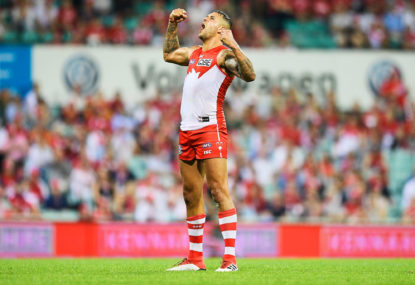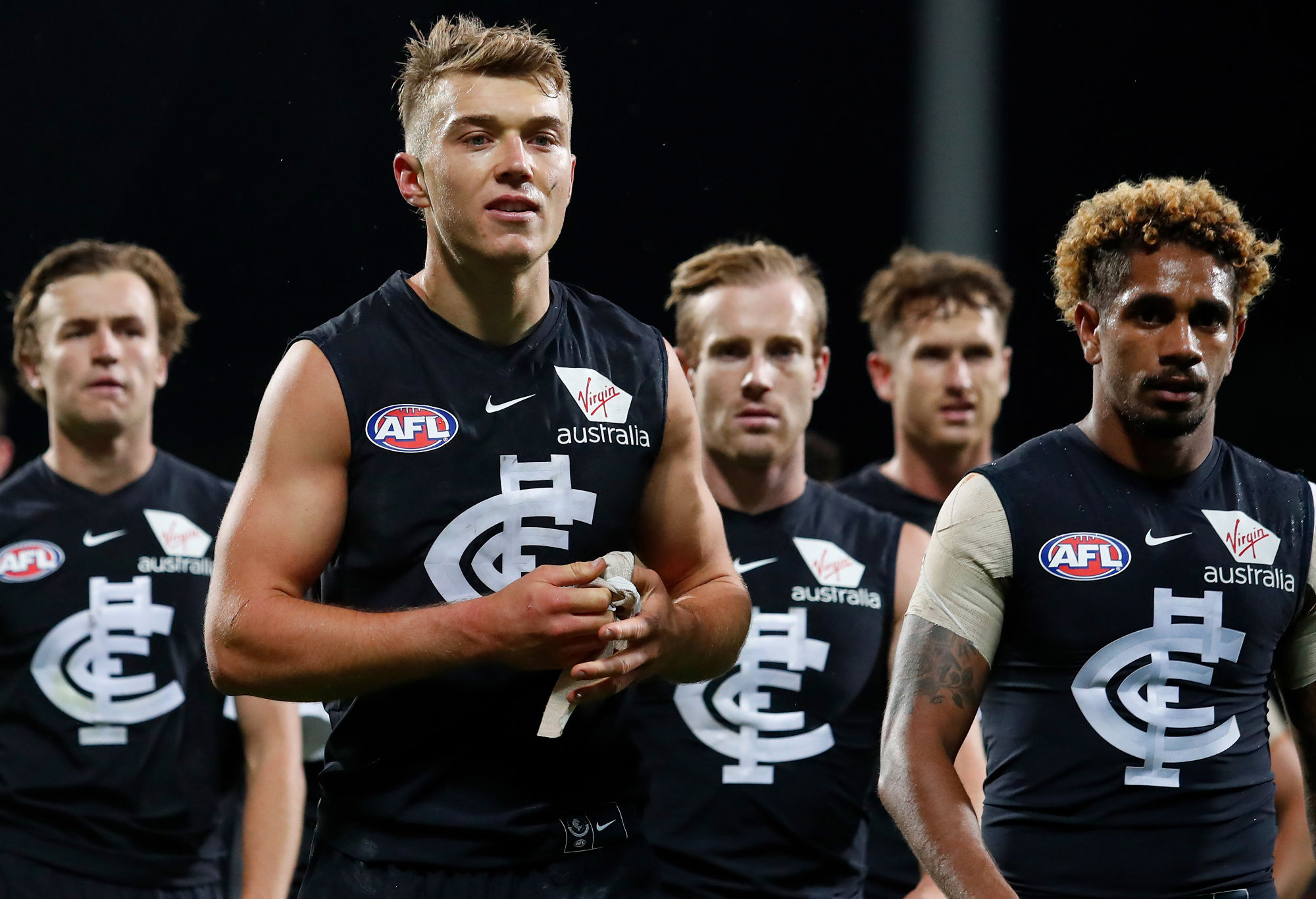Jeremy Cameron produces the two biggest shanks of his life at the worst possible time
One of the worst games of the star forward's whole career!

In the 121-year history of the league, only once has a team kicked so accurately that over 60% of its scores during the full season travelled between the big sticks, majors as opposed to behinds.
Keep in mind, the AFL and its predecessors don’t distinguish between a poor kick and a rushed behind – to the statisticians, rushed behinds are always credited as inaccurate kicks to the opposition. Lousy, in my mind, but it does simplify things, and as long as it’s equal for everyone…
That once happened recently, as you might have guessed (in 1897, the league-wide accuracy percentage was just 39.6%, last season, it was just shy of 53%, with generally steady improvement in between).
It happened with an otherwise unremarkable 2004 St Kilda team that went 16-6, placed third in the league before losing by a goal to eventual champion Port Adelaide in the preliminary final and oh yes, kicked 370 goals on the season (highest in the league that year) while only scoring 223 one-pointers that year (fifth fewest, no one ahead of them within 100 goals of the Saints).
Why were they so much higher that season? Honestly, I struggle to find one specific reason. In 2004, their opponent kicking accuracy was also remarkably high (57%, second highest in the AFL), so there may have been a bit of a Paul Westphal “offence-trumps-defence” attitude that year (whoops! Sorry! In my native US right now, “trumps” is a dirty word).
But the Saints were well above average throughout the decade, from their lowest point, gaining just six wins in 2000-2001 combined (when they still kicked 56%), through those landmark near-championship seasons of 2009 and 2010 (except for the one year in 2007 when they not only had more minors than majors for the only time in that stretch but missed the finals as well).
In 2004, Fraser Gehrig kicked 103 goals and just 38 behinds. Nick Riewoldt went 67.32, Stephen Milne kicked 46.22 for the year and Brent Guerra was a superb 29.5 on the season. None of the players in double-figure goal totals had worse than 50% accuracy.
That consistency up and down the line-up is undoubtedly part of the reason they achieved a number never seen before or since over a full season.
Sydney demonstrated how important kicking accuracy is Friday night. Ten minutes into the fourth quarter, with Adelaide leading 85-58 – down 27 points at home – the Swans made the last seven scores of the game, holding the Crows scoreless over the final twenty minutes. Simple math tells us that had they made five goals two, they would have won; four goals three, and they draw.
Over the first four games this season, they had kicked 57.33 with 63% accuracy.
Let John Longmire choose his kickers, and he very likely might have chosen Isaac Heeney, George Hewett, Gary Rohan and that guy named Buddy. That seems a very promising line-up. 63%? Had he known what was coming, he would have thought, we should be safe.
They converted just two out of seven. Two goals five. The Swans lost by ten.
Kicking accuracy is underrated at times. ¨Good kicking is good footy¨, sure. But maybe we fail to take it to heart in practice, like free throw shooting in basketball, or putting in golf. We will have to see what it costs the Swans down the road in this already extremely tight, unpredictable season.
It cost their cross-town rivals a win this weekend as well. The Giants were at least four-goal favourites over the Saints Saturday afternoon, but despite the fact that St Kilda hardly lived up to the standards of their last-decade predecessors, kicking just 10.13 (under 44 percent for the game; their disposal accuracy was equally weak), the charcoal-and-orange were far worse, kicking only nine of their 28 scoring shots between the big sticks and having to settle for a draw with their bottom four opponents at 73 apiece.
Kicking 9.19 is poor in the worst of conditions, but under the roof at Etihad, for a top-four team to have its stars miss some of the set shots they missed was nothing short of embarrassing.
When you first hear that two AFL teams have played to a draw, as the Giants have now done in three of their last fourteen home-and-away games, do you normally assume, as I do, that they probably scored the same number of goals? I mean, would it not seem unusual to you if one team made up for a lack of a goal with six minor scores, coincidentally just happening to land on the same final total?

(Photo by Adam Trafford/AFL Media/Getty Images)
No? Is it just me? Hmm.
Regardless of our mutual psychological disorders, it happens to be that the more unusual circumstance is to have an identical scoreline across the board. In the history of the AFL (i.e., since 1990), only 20 of the 48 draws had final scorelines that resembled that of the Giants and Cats in R15 last year (10.8.68 apiece), while fully 58.3% of the games more closely resembled not just Saturday’s game (and the Giants/Hawks draw in R16 last season), but the infamous Collingwood/St Kilda grand final which put an end to the come-back-next-week method of settling finals matches.
In that first grand final, the Saints out-goaled the Magpies 10-9, but the black-and-white had six more single-point jobs; Collingwood won the following week with panache, 108-52.
The trend extends back to the beginning of the sport. From WW2 until its transformation to the national format, the league produced a whopping 57% (33 out of 58) draws which failed to produce matching scorelines.
Since the founding of the VFL in 1897, Saturday’s game was the 158th draw (thank you AFL Tables for these and many other stats in use on this site), and a full 56.3% have resulted from one team matching six behinds to a goal for the other side, rather than posting identical major-minor scorecards.
Two quick notes on this before we leave the topic: one is that we noticed that the reason the percentage of identical scorelines is continuing to decrease slightly over the decades is because the total scores were getting higher throughout the 20th century – there are more ways to count to, say, 94 than there are ways to count to 49.
Also, because accuracy rates are steadily improving league-wide, it has become more likely to have one team kick something like 16.6 to offset 15.12 or even 14.16 than it might have been when the average accuracy rate was in the low forties.
Secondly, it would seem pretty obvious that it would be more likely for the teams to differ by one goal to six behinds than, say, by two goals for one team to twelve behinds for the other. But it will be hard to top the 1948 grand final when Melbourne managed to tie Essendon despite the Bombers connecting on fifteen more scoring shots than the Demons.
You read that right: Melbourne kicked 10.9.69, while Essendon managed a woeful 7.27.69. That game remains, alongside a 1935 clash where Carlton only hit 9.25.79 against Footscray (12.7.79), as one of the only two draws in VFL/AFL history where two drawn teams were separated by as many as three full goals.
In the 1948 grand final rematch the following week, by the way, Melbourne defeated the minor premiers 89-50 to take the crown.
The kicking issues are bound to be a problem for clubs again this season, if only from game to game. West Coast let Carlton stay in the match with them Saturday despite ten more scoring shots by kicking 10 goals 19 for the match, while the Blues converted over 50 percent.

(Photo by Adam Trafford/AFL Media/Getty Images)
This season, there have been four matches where the losing team scored more often than the winning squad, which anecdotally is on par with past years (just under once per round). It happens more often than it should, quite honestly, and when it looks like the two Harbour City team performances this weekend, it’s an issue that needs to be addressed in practice the following week, at the least.
It’s too early to evaluate all of Round 5’s results, but here’s a quick and premature look at Round 6:
Four games look like easy wins for GWS, Hawthorn, Adelaide and West Coast (over Brisbane, St Kilda, Gold Coast, and Fremantle respectively). Richmond and Port seem like the preferences in their games (against Collingwood and the Kangaroos), leaving the Bulldogs/Blues, Geelong/Sydney and Essendon/Melbourne games to flip coins over.
I really want to take Footscray Friday against an inferior and injury-racked Carlton team, but it’s hard to after their Round 5 performances. Neither club deserves a Friday showcase right now, regardless of how competitive the game might end up being.
The Swans are the better team in the Saturday match-up, but at Kardinia Park, the line-ups will make the difference. And as for the ANZAC aftermath, I want to see how the holiday game performances go before picking a Dons/Demons winner.